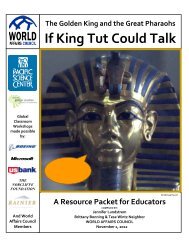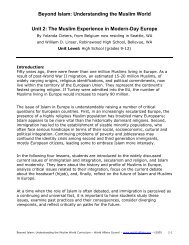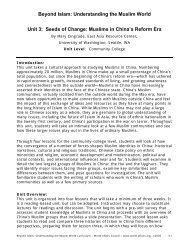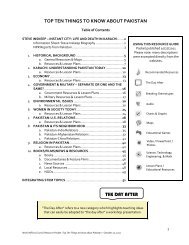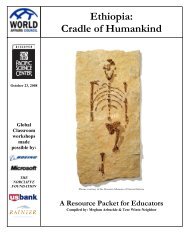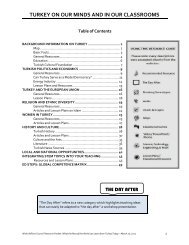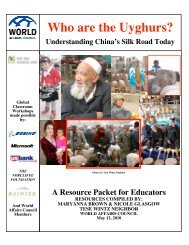The Japanese Approach to Environmental Issues - World Affairs ...
The Japanese Approach to Environmental Issues - World Affairs ...
The Japanese Approach to Environmental Issues - World Affairs ...
Create successful ePaper yourself
Turn your PDF publications into a flip-book with our unique Google optimized e-Paper software.
Meeting Needs and Wants: U.S. and <strong>Japanese</strong> Transportation Innovations in the 1950s and 1960sACTIVITY 3: CULTURE AND VALUES EXPLORATIONOverview of activity: This activity will help students identify “rights, values, and beliefs” that mayaffect U.S. and <strong>Japanese</strong> economic choices. Please emphasize <strong>to</strong> students that this activity requiresthem <strong>to</strong> generalize as they describe two complex societies using broad brush strokes. <strong>The</strong>re aremany differences in culture and values between individuals, families, communities, and regionswithin both countries. Students should discuss and revisit the concept of stereotyping at thebeginning and end of the lesson as a reminder that these descriptions are not intended <strong>to</strong> describeindividuals within each culture.Part 2: <strong>Japanese</strong> and American ValuesVisit Columbia University’s Asia for Educa<strong>to</strong>rs: <strong>Japanese</strong> Culture and Society site:http://afe.easia.columbia.edu/at_japan_soc/Harvard professors <strong>The</strong>odore Bes<strong>to</strong>r (anthropology) and Helen Hardacre (<strong>Japanese</strong> society andreligion) explain aspects of <strong>Japanese</strong> culture and society in short videos.Pass out Handout #3: <strong>Japanese</strong> and American Culture and Values <strong>to</strong> students. Ask them <strong>to</strong>watch the videos and/or read the transcripts, conduct independent research, and fill in the table.Students may begin their independent research by using the resources listed in this packet and alsoin the Global Classroom resource packet on “<strong>The</strong> <strong>Japanese</strong> <strong>Approach</strong> <strong>to</strong> <strong>Environmental</strong> <strong>Issues</strong>,”which may be found at: http://www.world-affairs.org/globalclassroom/resourcepackets.htmACTIVITY 4: USING TRANSPORTATION TO MEET NEEDS & WANTSOverview of activity: This activity asks students <strong>to</strong> begin exploring transportation innovations inthe specific context of the U.S. and Japan in the 1950s and 1960s. Students will start by gaining abasic understanding of geography and population density in the two countries. Next, they willresearch the development of the interstate and shinkansen systems and consider who “won” and“lost” as a result of these developments.Part 1: Comparing Population DensityVisit the Ask Asia website lesson plan entitled “How Big is Big? A Population Density Exercise”:http://www.askasia.org/teachers/lessons/plan.php?no=81&era=&grade=&geoThis whole-class exercise helps students understand population density and spatial relations inunderstandable, comparable terms. Students, with some classroom <strong>to</strong>ols, will learn about <strong>Japanese</strong>population density by visualizing approximate and relative sizes of the world's regions andpopulations and using comparison and analogies <strong>to</strong> gain a clearer understanding of the world inwhich they live.Note: Ask students <strong>to</strong> use population figures in the 1950s or 1960s for this activity. Time permitting,repeat the activity with current population figures.Part 2: Transportation Innovations in the U.S. and JapanTransportation: <strong>The</strong>y Say We Had a Revolution (Part 2)http://www.econedlink.org/lessons/index.cfm?lesson=nn725&page=teacherSkim the lesson plan and decide which parts you would like <strong>to</strong> do with your class.Scroll <strong>to</strong> the bot<strong>to</strong>m of the page. Extension Activity 2 asks students <strong>to</strong>:7



